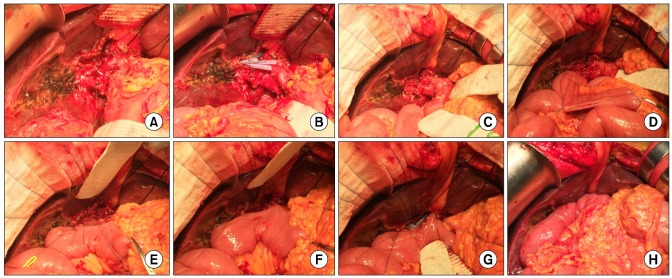Korean J Hepatobiliary Pancreat Surg.
2016 May;20(2):66-70. 10.14701/kjhbps.2016.20.2.66.
Cluster hepaticojejunostomy with radial spreading anchoring traction technique for secure reconstruction of widely opened hilar bile ducts
- Affiliations
-
- 1Department of Surgery, Asan Medical Center, University of Ulsan College of Medicine, Seoul, Korea. shwang@amc.seoul.kr
- KMID: 2243017
- DOI: http://doi.org/10.14701/kjhbps.2016.20.2.66
Abstract
- Secure reconstruction of multiple hepatic ducts that are severely damaged by tumor invasion or iatrogenic injury is a challenge. Failure of percutaneous or endoscopic biliary stenting requires lifelong placement of one or more percutaneous transhepatic biliary drainage (PTBD) tubes. For such difficult situations, we devised a surgical technique termed cluster hepaticojejunostomy (HJ), which can be coupled with palliative bile duct resection. The cluster HJ technique consisted of applying multiple internal biliary stents and a single wide porto-enterostomy to the surrounding connective tissues. The technique is described in detail in the present case report. Performing cluster HJ benefits from three technical tips as follows: making the multiple bile duct openings wide and parallel after sequential side-to-side unification; radially anchoring and traction of the suture materials at the anterior anastomotic suture line; and making multiple segmented continuous sutures at the posterior anastomotic suture line. Thus, cluster HJ with radial spreading anchoring traction technique is a useful surgical method for secure reconstruction of severely damaged hilar bile ducts.
Keyword
Figure
Cited by 2 articles
-
Hilar portal vein wedge resection and patch venoplasty in patients undergoing bile duct resection for hepatobiliary malignancy: A report of two cases
Sung-Min Kim, Shin Hwang
Ann Hepatobiliary Pancreat Surg. 2021;25(1):132-138. doi: 10.14701/ahbps.2021.25.1.132.Indication and surgical techniques of bypass choledochojejunostomy for intractable choledocholithiasis
Shin Hwang, Dong-Hwan Jung, Sung Koo Lee, Myung-Hwan Kim
Ann Hepatobiliary Pancreat Surg. 2021;25(2):259-264. doi: 10.14701/ahbps.2021.25.2.259.
Reference
-
1. Hwang S, Song GW, Ha TY, Lee YJ, Kim KH, Ahn CS, et al. Reappraisal of percutaneous transhepatic biliary drainage tract recurrence after resection of perihilar bile duct cancer. World J Surg. 2012; 36:379–385. PMID: 22159824.
Article2. Hwang S, Lee SG, Lee YJ, Ahn CS, Kim KH, Moon DB, et al. Treatment of recurrent bile duct stricture after primary reconstruction for laparoscopic cholecystectomy-induced injury. Surg Laparosc Endosc Percutan Tech. 2008; 18:445–448. PMID: 18936662.
Article3. Law R, Baron TH. Bilateral metal stents for hilar biliary obstruction using a 6Fr delivery system: outcomes following bilateral and side-by-side stent deployment. Dig Dis Sci. 2013; 58:2667–2672. PMID: 23625287.
Article4. Maillard M, Novellas S, Baudin G, Evesque L, Bellmann L, Gugenheim J, et al. Placement of metallic biliary endoprostheses in complex hilar tumours. Diagn Interv Imaging. 2012; 93:767–774. PMID: 22921689.
Article5. Lee TH, Park do H, Lee SS, Choi HJ, Lee JK, Kim TH, et al. Technical feasibility and revision efficacy of the sequential deployment of endoscopic bilateral side-by-side metal stents for malignant hilar biliary strictures: a multicenter prospective study. Dig Dis Sci. 2013; 58:547–555. PMID: 22886596.
Article6. Sangchan A, Kongkasame W, Pugkhem A, Jenwitheesuk K, Mairiang P. Efficacy of metal and plastic stents in unresectable complex hilar cholangiocarcinoma: a randomized controlled trial. Gastrointest Endosc. 2012; 76:93–99. PMID: 22595446.
Article7. Ha TY, Hwang S, Song GW, Jung DH, Kim MH, Lee SG, et al. Cluster hepaticojejunostomy is a useful technique enabling secure reconstruction of severely damaged hilar bile ducts. J Gastrointest Surg. 2015; 19:1537–1541. PMID: 25956723.
Article8. Abraham NS, Barkun JS, Barkun AN. Palliation of malignant biliary obstruction: a prospective trial examining impact on quality of life. Gastrointest Endosc. 2002; 56:835–841. PMID: 12447294.
Article9. Judah JR, Draganov PV. Endoscopic therapy of benign biliary strictures. World J Gastroenterol. 2007; 13:3531–3539. PMID: 17659703.
Article10. Tsukamoto T, Hirohashi K, Kubo S, Tanaka H, Hamba H, Shuto T, et al. Self-expanding metallic stent for benign biliary strictures: seven-year follow-up. Hepatogastroenterology. 2004; 51:658–660. PMID: 15143886.11. Tocchi A, Mazzoni G, Liotta G, Costa G, Lepre L, Miccini M, et al. Management of benign biliary strictures: biliary enteric anastomosis vs endoscopic stenting. Arch Surg. 2000; 135:153–157. PMID: 10668872.12. Siriwardana HP, Siriwardena AK. Systematic appraisal of the role of metallic endobiliary stents in the treatment of benign bile duct stricture. Ann Surg. 2005; 242:10–19. PMID: 15973096.
Article13. Kasai M, Kimura S, Asakura Y, Suzuki H, Taira Y, Ohashi E. Surgical treatment of biliary atresia. J Pediatr Surg. 1968; 3:665–675.
Article
- Full Text Links
- Actions
-
Cited
- CITED
-
- Close
- Share
- Similar articles
-
- Hilar Cholangiocarcinoma
- Nasogastric tube placement into the hepaticojejunostomy anastomosis in pancreaticoduodenectomy: a simple surgical technique for prevention of bile leak
- Hilar Cholangiocarcinoma: Recent update of radiologic assessment
- Management of Advanced Hilar Biliary Malignancy with X-shaped Stenting Technique
- Radiological Staging of Hilar Cholangiocarcinoma


